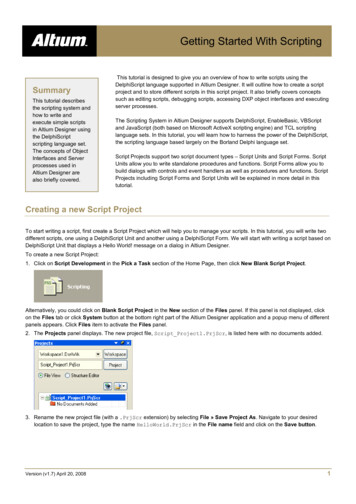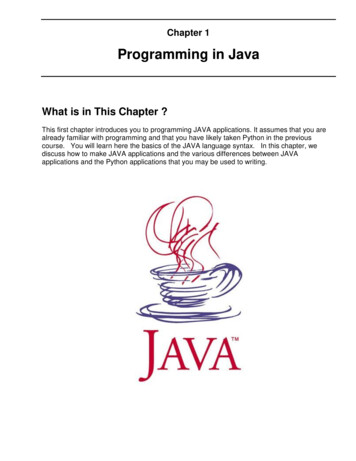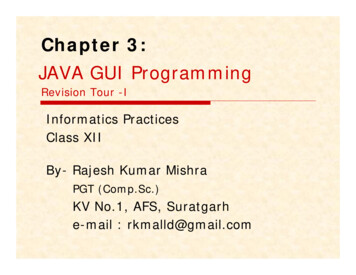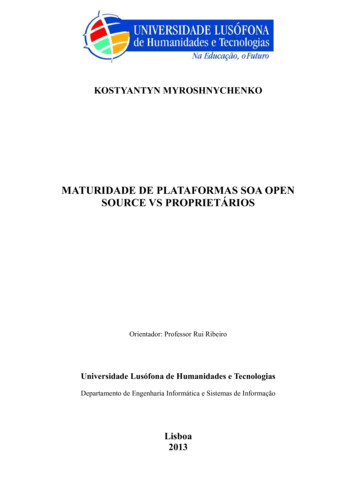
Transcription
Java Platform, Standard EditionJava Scripting Programmer's GuideRelease 11E94834-03October 2020
Java Platform, Standard Edition Java Scripting Programmer's Guide, Release 11E94834-03Copyright 2015, 2020, Oracle and/or its affiliates.This software and related documentation are provided under a license agreement containing restrictions onuse and disclosure and are protected by intellectual property laws. Except as expressly permitted in yourlicense agreement or allowed by law, you may not use, copy, reproduce, translate, broadcast, modify, license,transmit, distribute, exhibit, perform, publish, or display any part, in any form, or by any means. Reverseengineering, disassembly, or decompilation of this software, unless required by law for interoperability, isprohibited.The information contained herein is subject to change without notice and is not warranted to be error-free. Ifyou find any errors, please report them to us in writing.If this is software or related documentation that is delivered to the U.S. Government or anyone licensing it onbehalf of the U.S. Government, then the following notice is applicable:U.S. GOVERNMENT END USERS: Oracle programs (including any operating system, integrated software,any programs embedded, installed or activated on delivered hardware, and modifications of such programs)and Oracle computer documentation or other Oracle data delivered to or accessed by U.S. Governmentend users are "commercial computer software" or "commercial computer software documentation" pursuantto the applicable Federal Acquisition Regulation and agency-specific supplemental regulations. As such,the use, reproduction, duplication, release, display, disclosure, modification, preparation of derivative works,and/or adaptation of i) Oracle programs (including any operating system, integrated software, any programsembedded, installed or activated on delivered hardware, and modifications of such programs), ii) Oraclecomputer documentation and/or iii) other Oracle data, is subject to the rights and limitations specified in thelicense contained in the applicable contract. The terms governing the U.S. Government’s use of Oracle cloudservices are defined by the applicable contract for such services. No other rights are granted to the U.S.Government.This software or hardware is developed for general use in a variety of information management applications.It is not developed or intended for use in any inherently dangerous applications, including applications thatmay create a risk of personal injury. If you use this software or hardware in dangerous applications, then youshall be responsible to take all appropriate fail-safe, backup, redundancy, and other measures to ensure itssafe use. Oracle Corporation and its affiliates disclaim any liability for any damages caused by use of thissoftware or hardware in dangerous applications.Oracle and Java are registered trademarks of Oracle and/or its affiliates. Other names may be trademarks oftheir respective owners.Intel and Intel Inside are trademarks or registered trademarks of Intel Corporation. All SPARC trademarks areused under license and are trademarks or registered trademarks of SPARC International, Inc. AMD, Epyc,and the AMD logo are trademarks or registered trademarks of Advanced Micro Devices. UNIX is a registeredtrademark of The Open Group.This software or hardware and documentation may provide access to or information about content, products,and services from third parties. Oracle Corporation and its affiliates are not responsible for and expresslydisclaim all warranties of any kind with respect to third-party content, products, and services unless otherwiseset forth in an applicable agreement between you and Oracle. Oracle Corporation and its affiliates will notbe responsible for any loss, costs, or damages incurred due to your access to or use of third-party content,products, or services, except as set forth in an applicable agreement between you and Oracle.
ContentsPrefaceAudienceivDocumentation AccessibilityivRelated DocumentsivConventionsiv1Scripting Languages and Java2The Java Scripting API3The JavaScript Package2-1How to Use the Java Scripting API to Embed Scripts2-1Java Scripting API Examples with Java Classes2-2Using Java from ScriptsAccessing Java Classes3-1Importing Java Packages and Classes3-3Using Java Arrays3-4Implementing Java Interfaces3-5Extending Abstract Java Classes3-5Extending Concrete Java Classes3-6Accessing Methods of a Superclass3-7Binding Implementations to Classes3-7Selecting Method Overload Variant3-9Mapping Data Types3-9Passing JSON Objects to Java3-10iii
PrefacePrefaceThis document provides an overview of the scripting features in Java Platform,Standard Edition (Java SE).AudienceThis document is intended for Java application programmers who want to executecode written in scripting languages. It is assumed that the you are familiar with Javaand a version of the ECMAScript language standard (JavaScript).Documentation AccessibilityFor information about Oracle's commitment to accessibility, visit theOracle Accessibility Program website at http://www.oracle.com/pls/topic/lookup?ctx acc&id docacc.Access to Oracle SupportOracle customers that have purchased support have access to electronic supportthrough My Oracle Support. For information, visit http://www.oracle.com/pls/topic/lookup?ctx acc&id info or visit http://www.oracle.com/pls/topic/lookup?ctx acc&id trsif you are hearing impaired.Related DocumentsSee the Java Scripting API specification, the javax.script package.ConventionsThe following text conventions are used in this document:ConventionMeaningboldfaceBoldface type indicates graphical user interface elements associatedwith an action, or terms defined in text or the glossary.italicItalic type indicates book titles, emphasis, or placeholder variables forwhich you supply particular values.monospaceMonospace type indicates commands within a paragraph, URLs, codein examples, text that appears on the screen, or text that you enter.iv
1Scripting Languages and JavaThis section describes the characteristics of scripting languages and how they can beused by Java programmers.Scripting languages are programming languages that support the ability to writescripts. Unlike source files for other programming languages that must be compiledinto bytecode before you run them, scripts are evaluated by a runtime environment (inthis case, by a script engine) directly.Most scripting languages are dynamically typed. This enables you to create newvariables without declaring the variable type (the interpreter assigns the type basedon the type of the object associated with the variable), and you can reuse the samevariable for objects of different types (type conversion is performed automatically).Scripting languages generally have simple syntax; they allow complex tasks to beperformed in relatively few steps.Although scripting languages are usually interpreted at runtime, they can be compiledinto Java bytecode that can then be executed on the Java Virtual Machine (JVM).Scripting languages can be faster and easier to use for certain problems, so it issometimes chosen by developers of Java applications. However, if you write your Javaapplication in a scripting language, then you lose the benefits of the Java language(such as type safety and access to the class library).Java Specification Request (JSR) 223: Scripting for the Java Platform addresses theissue of integrating Java and scripting languages. It defines a standard framework andapplication programming interface (API) to embed scripts in your Java applicationsand access Java objects from scripts.By embedding scripts in your Java code, you can customize and extend the Javaapplication. For example, you can have configuration parameters, business logic,math expressions, and other external parts written as scripts. When developing yourJava application, you do not need to choose the scripting language. If you write yourapplication with the Java Scripting API (defined by JSR 223), then users can writescripts in any language compliant with JSR 223. See The Java Scripting API.When writing a script in a language compliant with JSR 223, you have access to theentire standard Java library. See Using Java from Scripts.1-1
2The Java Scripting APIThis section introduces the Java Scripting API and describes how the Java ScriptingAPI (defined by JSR 223) is used to embed scripts in your Java applications. It alsoprovides a number of examples with Java classes, which demonstrate the features ofthe Java Scripting API.Note:The Nashorn engine is deprecated in JDK 11 in preparation for removal in afuture release.Topics The JavaScript Package How to Use the Java Scripting API to Embed ScriptsThe JavaScript PackageThe Java Scripting API consists of classes and interfaces from the javax.scriptpackage. It is a relatively small and simple package with the ScriptEngineManagerclass as the starting point. A ScriptEngineManager object can discover script enginesthrough the JAR file service discovery mechanism, and instantiate ScriptEngineobjects that interpret scripts written in a specific scripting language.The Nashorn engine is the default ECMAScript (JavaScript) engine bundled with theJava SE Development Kit (JDK). The Nashorn engine was developed fully in Java byOracle as part of an OpenJDK project, Project Nashorn.Although Nashorn is the default ECMAScript engine used by the Java ScriptingAPI, you can use any script engine compliant with JSR 223, or you can implementyour own. This document does not cover the implementation of script enginescompliant with JSR 223, but at the most basic level, you must implement thejavax.script.ScriptEngine and javax.script.ScriptEngineFactory interfaces.The abstract class javax.script.AbstractScriptEngine provides useful defaults fora few methods in the ScriptEngine interface.How to Use the Java Scripting API to Embed ScriptsTo use the Java Scripting API:1.Create a ScriptEngineManager object.2.Get a ScriptEngine object from the manager.3.Evaluate the script using the script engine's eval() method.2-1
Chapter 2Java Scripting API Examples with Java ClassesJava Scripting API Examples with Java ClassesThe following examples show you how to use the Java Scripting API in Java. To keepthe examples simple, exceptions are not handled. However, there are checked andruntime exceptions thrown by the Java Scripting API, and they should be properlyhandled. In every example, an instance of the ScriptEngineManager class is usedto request the Nashorn engine (an object of the ScriptEngine class) using thegetEngineByName() method. If the engine with the specified name is not present, nullis returned. For more information about using the Nashorn engine, see the NashornUser's Guide.Note:Each ScriptEngine object has its own variable scope; see Using MultipleScopes.Evaluating a StatementIn this example, the eval() method is called on the script engine instance to executeJavaScript code from a String object.import javax.script.*;public class EvalScript {public static void main(String[] args) throws Exception {ScriptEngineManager manager new ScriptEngineManager();ScriptEngine engine manager.getEngineByName("nashorn");// evaluate JavaScript codeengine.eval("print('Hello, World')");}}Evaluating a Script FileIn this example, the eval() method takes in a FileReader object that reads JavaScriptcode from a file named script.js. By wrapping various input stream objects asreaders, it is possible to execute scripts from files, URLs, and other resources.import javax.script.*;public class EvalFile {public static void main(String[] args) throws Exception {ScriptEngineManager manager new ScriptEngineManager();ScriptEngine engine manager.getEngineByName("nashorn");// evaluate JavaScript codeengine.eval(new java.io.FileReader("script.js"));}}2-2
Chapter 2Java Scripting API Examples with Java ClassesExposing a Java Object as a Global VariableIn this example, a File object is created and exposed to the engine as a globalvariable named file using the put() method. Then the eval() method is called withJavaScript code that accesses the variable and calls the getAbsolutePath() method.Note:The syntax to access fields and call methods of Java objects exposed asvariables depends on the scripting language. This example uses JavaScriptsyntax, which is similar to Java.import javax.script.*;import java.io.*;public class ScriptVars {public static void main(String[] args) throws Exception {ScriptEngineManager manager new ScriptEngineManager();ScriptEngine engine manager.getEngineByName("nashorn");// create File objectFile f new File("test.txt");// expose File object as a global variable to the engineengine.put("file", f);// evaluate JavaScript code and access the ");}}Invoking a Script FunctionIn this example, the eval() method is called with JavaScript code that definesa function with one parameter. Then, an Invocable object is created and itsinvokeFunction() method is used to invoke the function.Note:Not all script engines implement the Invocable interface. This exampleuses the Nashorn engine, which can invoke functions in scripts that havepreviously been evaluated by this engine.import javax.script.*;public class InvokeScriptFunction {public static void main(String[] args) throws Exception {ScriptEngineManager manager new ScriptEngineManager();ScriptEngine engine manager.getEngineByName("nashorn");// evaluate JavaScript code that defines a function with one parameterengine.eval("function hello(name) { print('Hello, ' name) }");2-3
Chapter 2Java Scripting API Examples with Java Classes// create an Invocable object by casting the script engine objectInvocable inv (Invocable) engine;// invoke the function named "hello" with "Scripting!" as the argumentinv.invokeFunction("hello", "Scripting!");}}Invoking a Script Object's MethodIn this example, the eval() method is called with JavaScript code that definesan object with a method. This object is then exposed from the script to the Javaapplication using the script engine's get() method. Then, an Invocable object iscreated, and its invokeMethod() method is used to invoke the method defined for thescript object.Note:Not all script engines implement the Invocable interface. This exampleuses the Nashorn engine, which can invoke methods in scripts that havepreviously been evaluated by this engine.import javax.script.*;public class InvokeScriptMethod {public static void main(String[] args) throws Exception {ScriptEngineManager manager new ScriptEngineManager();ScriptEngine engine manager.getEngineByName("nashorn");// evaluate JavaScript code that defines an object with one methodengine.eval("var obj new Object()");engine.eval("obj.hello function(name) { print('Hello, ' name) }");// expose object defined in the script to the Java applicationObject obj engine.get("obj");// create an Invocable object by casting the script engine objectInvocable inv (Invocable) engine;// invoke the method named "hello" on the object defined in the script// with "Script Method!" as the argumentinv.invokeMethod(obj, "hello", "Script Method!");}}Implementing a Java Interface with Script FunctionsIn this example, the eval() method is called with JavaScript code that defines afunction. Then, an Invocable object is created, and its getInterface() methodis used to create a Runnable interface object. The methods of the interface areimplemented by script functions with matching names (in this case, the run() functionis used to implement the run() method in the interface object). Finally, a new thread isstarted that runs the script function.2-4
Chapter 2Java Scripting API Examples with Java Classesimport javax.script.*;public class ImplementRunnable {public static void main(String[] args) throws Exception {ScriptEngineManager manager new ScriptEngineManager();ScriptEngine engine manager.getEngineByName("nashorn");// evaluate JavaScript code that defines a function with one parameterengine.eval("function run() { print('run() function called') }");// create an Invocable object by casting the script engine objectInvocable inv (Invocable) engine;// get Runnable interface objectRunnable r inv.getInterface(Runnable.class);// start a new thread that runs the scriptThread th new Thread(r);th.start();th.join();}}Implementing a Java Interface with the Script Object's MethodsIn this example, the eval() method is called with JavaScript code that definesan object with a method. This object is then exposed from the script to the Javaapplication using the script engine's get() method. Then, an Invocable object iscreated, and its getInterface() method is used to create a Runnable interface object.The methods of the interface are implemented by the script object's methods withmatching names (in this case, the run method of the obj object is used to implementthe run() method in the interface object). Finally, a new thread is started that runs thescript object's method.import javax.script.*;public class ImplementRunnableObject {public static void main(String[] args) throws Exception {ScriptEngineManager manager new ScriptEngineManager();ScriptEngine engine manager.getEngineByName("nashorn");// evaluate JavaScript code that defines a function with one parameterengine.eval("var obj new Object()")engine.eval("obj.run function() { print('obj.run() method called') }");// expose object defined in the script to the Java applicationObject obj engine.get("obj");// create an Invocable object by casting the script engine objectInvocable inv (Invocable) engine;// get Runnable interface objectRunnable r inv.getInterface(obj, Runnable.class);// start a new thread that runs the scriptThread th new Thread(r);th.start();th.join();}}2-5
Chapter 2Java Scripting API Examples with Java ClassesUsing Multiple ScopesIn this example, the script engine's put() method is used to set the variable x to aString object hello. Then, the eval() method is used to print the variable in thedefault scope. Then, a different script context is defined, and its scope is used to setthe same variable to a different value (a String object world). Finally, the variable isprinted in the new script context that displays a different value.A single scope is an instance of the javax.script.Bindings interface. This interfaceis derived from the java.util.Map String, Object interface. A scope is a setof name and value pairs where the name is a non-empty, non-null String object.The javax.script.ScriptContext interface supports multiple scopes with associatedBindings for each scope. By default, every script engine has a default script context.The default script context has at least one scope represented by the static fieldENGINE SCOPE. Various scopes supported by a script context are available throughthe getScopes() method.import javax.script.*;public class MultipleScopes {public static void main(String[] args) throws Exception {ScriptEngineManager manager new ScriptEngineManager();ScriptEngine engine manager.getEngineByName("nashorn");// set global variableengine.put("x","hello");// evaluate JavaScript code that prints the variable (x "hello")engine.eval("print(x)");// define a different script contextScriptContext newContext new e.createBindings(),ScriptContext.ENGINE SCOPE);Bindings engineScope newContext.getBindings(ScriptContext.ENGINE SCOPE);// set the variable to a different value in another scopeengineScope.put("x", "world");// evaluate the same code but in a different script context (x "world")engine.eval("print(x)", newContext);2-6
3Using Java from ScriptsThis section describes how to access Java classes and interfaces from scripts.Note:The Nashorn engine is deprecated in JDK 11 in preparation for removal in afuture release.The code snippets are written in JavaScript, but you can use any scripting languagecompliant with JSR 223. Examples can be used as script files, or can be run in aninteractive shell one expression at a time. The syntax for accessing fields and methodsof objects is the same in JavaScript as it is in Java.Topics Accessing Java Classes Importing Java Packages and Classes Using Java Arrays Implementing Java Interfaces Extending Abstract Java Classes Extending Concrete Java Classes Accessing Java Classes Binding Implementations to Classes Selecting Method Overload Variant Mapping Data Types Passing JSON Objects to JavaAccessing Java ClassesTo access primitive and reference Java types from JavaScript, call the Java.type()function, which returns a type object that corresponds to the full name of the classpassed in as a string. The following example shows you how to get various typeobjects:varvarvarvarArrayList Java.type("java.util.ArrayList");intType Java.type("int");StringArrayType Java.type("java.lang.String[]");int2DArrayType Java.type("int[][]");The type object returned by the Java.type() function can be used in JavaScript codesimilar to how a class name is used in Java. For example, you can can use it toinstantiate new objects as follows:3-1
Chapter 3Accessing Java Classesvar anArrayList new Java.type("java.util.ArrayList");Java type objects can be used to instantiate new Java objects. The following exampleshows you how to instantiate new objects using the default constructor and by passingarguments to another constructor:var ArrayList Java.type("java.util.ArrayList");var defaultSizeArrayList new ArrayList;var customSizeArrayList new ArrayList(16);You can use the type object returned by the Java.type() function to access staticfields and methods as follows:var File horn", ".tmp");To access a static inner class, use the dollar sign ( ) in the argument passed to theJava.type() method. The following example shows how to return the type object ofthe Float inner class in java.awt.geom.Arc2D:var Float Java.type("java.awt.geom.Arc2D Float");If you already have the outer class type object, then you can access the inner class asa property of the outer class as follows:var Arc2D Java.type("java.awt.geom.Arc2D")var Float Arc2D.FloatIn case of a nonstatic inner class, you must pass an instance of the outer class as thefirst argument to the constructor.Although a type object in JavaScript is used similar to the Java class, it is distinctfrom the java.lang.Class object, which is returned by the getClass() method. Youcan obtain one from the other using the class and static properties. The followingexample shows this distinction:var ArrayList Java.type("java.util.ArrayList");var a new ArrayList;// All of the following are true:print("Type acts as target of instanceof: " (a instanceof ArrayList));print("Class doesn't act as target of instanceof: " !(a instanceofa.getClass()));print("Type is not the same as instance's getClass(): " (a.getClass() ! ArrayList));print("Type's class property is the same as instance's getClass(): " (a.getClass() ArrayList.class));print("Type is the same as the static property of the instance's getClass(): " (a.getClass().static ArrayList));Syntactically and semantically, this distinction between compile-time class expressionsand runtime class objects makes JavaScript similar to Java code. However, there isno equivalent of the static property for a Class object in Java, because compile-timeclass expressions are never expressed as objects.3-2
Chapter 3Importing Java Packages and ClassesImporting Java Packages and ClassesTo access Java classes by their simple names, you can use the importPackage() andimportClass() functions to import Java packages and classes. These functions arebuilt into the compatibility script (mozilla compat.js).Note:Avoid importing packages in production application code. Instead, importclasses with the importClass() function and save them as global variables.Limit the use of the importPackage() function to simple prototyping withJava classes.The following example shows you how to use the importPackage() andimportClass() functions:// Load compatibility scriptload("nashorn:mozilla compat.js");// Import the java.awt packageimportPackage(java.awt);// Import the java.awt.Frame classimportClass(java.awt.Frame);// Create a new Frame objectvar frame new java.awt.Frame("hello");// Call the setVisible() methodframe.setVisible(true);// Access a JavaBean propertyprint(frame.title);You can access Java packages using the Packages global variable (for example,Packages.java.util.Vector or Packages.javax.swing.JFrame), but standard JavaSE packages have shortcuts (java for Packages.java, javax for Packages.javax, andorg for Packages.org).The java.lang package is not imported by default, because its classes wouldconflict with Object, Boolean, Math, and other built-in JavaScript objects. Furthermore,importing any Java package or class can lead to conflicts with the global variablescope in JavaScript. To avoid this, define a JavaImporter object and use the withstatement to limit the scope of the imported Java packages and classes, as shown inthe following example:// Create a JavaImporter object with specified packages and classes to importvar Gui new JavaImporter(java.awt, javax.swing);// Pass the JavaImporter object to the "with" statement and access the classes// from the imported packages by their simple names within the statement's bodywith (Gui) {var awtframe new Frame("AWT Frame");var jframe new JFrame("Swing JFrame");};3-3
Chapter 3Using Java ArraysUsing Java ArraysTo create a Java array object, you first have to get the Java array type object, andthen instantiate it. The syntax for accessing array elements and the length property inJavaScript is the same as in Java, as shown in the following example:var StringArray Java.type("java.lang.String[]");var a new StringArray(5);// Set the value of the first elementa[0] "Scripting is great!";// Print the length of the arrayprint(a.length);// Print the value of the first elementprint(a[0]);Given a JavaScript array, you can convert it to a Java array using the Java.to()method. You must pass the JavaScript array variable to this method and the type ofarray to be returned, either as a string or a type object. You can also omit the arraytype argument to return an Object[] array. Conversion is performed according to theECMAScript conversion rules. The following example shows you how to convert aJavaScript array to a Java array using various Java.to() method arguments:// Create a JavaScript arrayvar anArray [1, "13", false];// Convert the JavaScript array to a Java int[] arrayvar javaIntArray Java.to(anArray, "int[]");print(javaIntArray[0]); // prints the number 1print(javaIntArray[1]); // prints the number 13print(javaIntArray[2]); // prints the number 0// Convert the JavaScript array to a Java String[] arrayvar javaStringArray Java.to(anArray, rray[0]); // prints the string "1"print(javaStringArray[1]); // prints the string "13"print(javaStringArray[2]); // prints the string "false"// Convert the JavaScript array to a Java Object[] arrayvar javaObjectArray Java.to(anArray);print(javaObjectArray[0]); // prints the number 1print(javaObjectArray[1]); // prints the string "13"print(javaObjectArray[2]); // prints the boolean value "false"Given a Java array, you can convert it to a JavaScript array using the Java.from()method. The following example shows you how to convert a Java array that contains alist of files in the current directory to a JavaScript array with the same contents:// Get the Java File type objectvar File Java.type("java.io.File");// Create a Java array of File objectsvar listCurDir new File(".").listFiles();// Convert the Java array to a JavaScript arrayvar jsList Java.from(listCurDir);// Print the JavaScript arrayprint(jsList);3-4
Chapter 3Implementing Java InterfacesNote:In most cases, you can use the Java array in scripts without converting theJava array to a JavaScript array.Implementing Java InterfacesThe syntax for implementing a Java interface in JavaScript is similar to howanonymous classes are declared in Java. You instantiate an interface and implementits methods (as JavaScript functions) in the same expression. The following exampleshows you how to implement the Runnable interface:// Create an object that implements the Runnable interface by implementing// the run() method as a JavaScript functionvar r new java.lang.Runnable() {run: function() {print("running.\n");}};// The r variable can be passed to Java methods that expect an objectimplementing// the java.lang.Runnable interfacevar th new java.lang.Thread(r);th.start();th.join();If a method expects an object that implements an interface with only one method,you can pass a script function to this method instead of the object. For instance, inthe previous example, the Thread() constructor expects an object that implementsthe Runnable interface, which defines only one method. You can take advantage ofautomatic conversion and pass a script function to the Thread() constructor insteadof the object. The following example shows you how you can create a Thread objectwithout implementing the Runnable interface:// Define a JavaScript functionfunction func() {print("I am func!");};// Pass the JavaScript function instead of an object that implements// the java.lang.Runnable interfacevar th new java.lang.Thread(func);th.start();th.join();You can implement multiple interfaces in a subclass by passing the relevant typeobjects to the Java.extend() function; see Extending Concrete Java Classes.Extending Abstract Java ClassesYou can instantiate an anonymous subclass of an abstract Java class by passing toits constructor a JavaScript object with properties whose values are functions thatimplement the abstract methods. If a method is overloaded, then
However, if you write your Java application in a scripting language, then you lose the benefits of the Java language (such as type safety and access to the class library). Java Specification Request (JSR) 223: Scripting for the Java Platform addresses the issue of integrating Java and scripting languages. It defines a standard framework and










